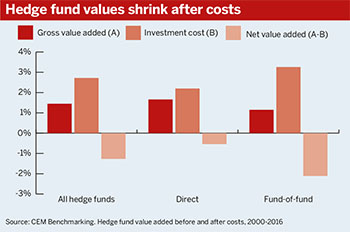Analysis: Since 2000, there has been an extraordinary rise in hedge fund investment. While only 2.1 per cent of large institutional investors had money in hedge funds in 2000, cost analysis service CEM Benchmarking says that this figure surpassed 50 per cent in 2016.
Total hedge fund industry capital globally increased by $4.5bn (£3.4bn) to $3.2tn, according to the latest HFR Global Hedge Fund Industry Report.

Investors have ploughed money into hedge funds in a race for returns and greater diversification in their portfolios. But high costs and poor benchmarking tools are beginning to deter schemes and their advisers from the asset class.
Investors have not always been getting what they thought they were getting
John Simmonds, CEM Benchmarking
Schemes looking for value may well be advised to look elsewhere. Average net value added of hedge funds was -1.27 per cent over the 17 years ending 2016, according to CEM.
Multi-asset funds, which combine a range of asset classes such as fixed income and equity, have pulled capital away from hedge funds in recent years, say experts.
Investors have been hoodwinked by hedge funds
Hedge funds are marketed as sources of returns that are uncorrelated with other assets. But CEM’s research, based on data from 382 funds, found that the average correlation to simple equity and debt blends stood at 85 per cent.
“In effect, investors have not always been getting what they thought they were getting, or could have got something very similar at much lower cost,” said John Simmonds, principal at CEM.
Simmonds recognised that a number of pension funds have bought into hedge funds that have outperformed. But he argued that they are in a minority, and could have achieved similar risk and return characteristics in simple passive combinations of debt and equity.
Soft benchmarks have also given a disingenuous impression of hedge fund performance, according to the cost analysis provider.
Funds that employ cash benchmarks outperform them by an average of 8.2 per cent per year, the CEM research shows. Twenty-nine per cent of funds surveyed used cash-based indices.
“Investable” benchmarks, on the other hand, allow investors to compare the performance of their hedge fund investment with alternative cheap solutions, Simmonds said.
“It’s not untypical in our experience for pension funds to set Libor, plus a premium, as a benchmark,” he said. “You can’t invest in Libor, so there’s no alternative low-cost solution.”
Should schemes move to multi-asset?
The £2.1bn Warwickshire County Council Pension Fund has sold off its hedge fund allocation, in anticipation of its move into the Border to Coast Pensions Partnership.
Mathew Dawson, treasury and pension fund manager at Warwickshire, according to the demands of Local Government Pension Scheme pooling and the lack of hedge fund exposure within the BCPP forced the scheme out of the asset class.
Ben Gold, head of pension investment, Leeds at XPS Pensions, said his consultancy is currently trying to steer schemes away from hedge funds. “They are expensive, and what they deliver is somewhat questionable,” he said.
“In recent times, the most equivalent in terms of a cheaper version of something that’s trying to generate relatively stable returns with low volatility is some of the multi-asset funds, particularly the more manager skill-oriented funds,” he added.
The London Borough of Haringey Pension Fund recently rebalanced 75 per cent of its overweight equities position into its multi-asset absolute returns and credit mandates, in an attempt to reduce the equity risk within its portfolio.
Hedge funds are beset by problems
Nearly 63 per cent of fund managers surveyed by data provider Evestment encountered net outflows from hedge funds in April, the highest level witnessed since October 2016.
Sara Rejal, global head of liquid diversifying strategies at consultancy Willis Towers Watson, said structural and behavioural problems have conspired to drag down hedge fund performance.
“We don’t think that the structures that hedge funds are in are very good. The fees, for sure, are far too high,” she said.
Warwickshire cuts hedge funds from portfolio
The £2.1bn Warwickshire County Council Pension Fund has sold off its hedge fund allocation in anticipation of its move into the Border to Coast Pensions Partnership.
While hedge funds yielded an average gross value added of 1.45 per cent, mean investment cost of 2.72 per cent dragged net value added down to -1.27 per cent, according to CEM.
Rejal also pinpointed an institutional mindset that has favoured generating low-volatility returns.
“We do think that given how difficult it’s been for hedge funds to make money, and how difficult it is to raise capital in this environment, they’ve become very conservative,” she said.














